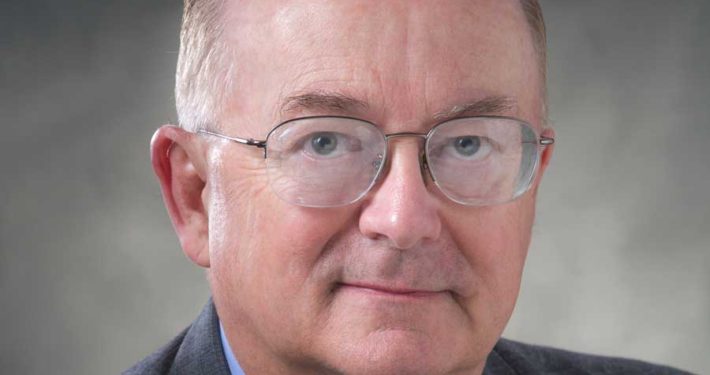How does a hundred-year-old practice maintain its mission, vision, and quality over time? El Paso Pediatrics offers a look into the structures, values, and patient-centered approaches that allow for continued success. Dr. Joseph Segapeli discusses the joys and challenges of working in this long-standing independent practice.
From Patient to Practitioner
How does a hundred-year-old pediatric practice maintain its mission, vision, and quality over time? Weathering staffing changes, urban growth, and rapid development in the medical field as well as pediatrics requires a strong foundation and dedicated physicians. El Paso Pediatrics has both. Dr. Joseph Segapeli, MD, discusses the joys and challenges of working in this long-standing independent practice.
While the group has undergone many changes since it opened in 1911, its internal mission and values remain intact. “The older pediatricians told me that they used to make rounds in the morning by stopping at a few patients’ houses on the way into work, then stopping at folks’ houses on their way home,” Dr. Segapeli says. “That’s different than what we do now, but familiarity is still at the heart of the practice. The mission has always been to provide good quality care to kids in our region.”
Dr. Segapeli began practicing with El Paso Pediatrics in 1987. He completed medical school at the University of Texas Health Science Center at San Antonio in 1981 and went on to complete his pediatric residency at William Beaumont Army Medical Center in 1984. Between 1984 and 1987, he was a pediatrician with the U.S. Army, stationed in Berlin, before returning to his hometown of El Paso. “Our origin story goes back a lot longer than I’ve been here,” Dr. Segapeli explains. “Back when I joined the practice it was four physicians, and when one was ready to retire I was recruited by him. He was actually my pediatrician growing up.”
By practicing at El Paso Pediatrics, Dr. Segapeli is nurturing deep roots in his community. He was born and raised in El Paso, leaving briefly for medical school and for his time in the army, but he has always felt pulled to serve children in this dynamic border city. “I grew up in a family of seven children, and we had a large charge account at this practice,” he says. “So I knew it was good quality care, and I wanted to pay it forward.”
Meeting Evolving Patients’ Needs
Over the life of the practice, the demographics of El Paso have changed as the city’s population has grown. “El Paso is a very diverse place,” says Dr. Segapeli. “We have a large Hispanic population given our border location, but we have a lot of immigrants of different nationalities from all over the world. About 40% of our practice is Medicaid, and we have many families who are CHIP [Children’s Health Insurance Program] insured. We strive to serve our Medicaid families as much as we can, and we have open panels. We’re fortunate enough to have a good local Medicaid provider organization. We keep our doors open to anyone in need.”
Dr. Segapeli identifies trends in his patient community that he is now working to address across the practice. “I’m excited about providing more to the area around obesity management and nutritional education,” he says. “We’re also reemphasizing the importance of vaccines to our patients.”
Education for patients and families of the importance of vaccines is especially important in Texas. In the spring of 2019, the state saw an unprecedented measles outbreak coupled with a bill brought by state representative Bill Zedler that would limit physicians’ ability to vaccinate their patients. Among other pieces of misinformation, Zedler has professed that the measles virus can be treated with antibiotics.1 Dr. Segapeli and his colleagues have their work cut out for them in Texas, and they combat a statewide dispersal of harmful pseudo-science. “We need to make sure that our information doesn’t get drowned out by the groaning of the anti-vaccers,” says Dr. Segapeli.
Dr. Segapeli highlights the demand for “efficient” medical care as a harmful new facet of the healthcare field, and one that can detract from the viability of independent practices. “We’ve moved into the age of the internet, of instant information,” says Dr. Segapeli. “So patients tend to expect instant gratification. Some patients now expect a quick fix for illnesses that have developed over a long time. I tell my patients that even if a prescription made them feel better momentarily, it might not be what’s best for their health in the long run. That’s a hard thing to explain to people who are used to pulling something up on their phone right away.”
“What’s more, there’s an explosion of places that are willing to do that— just give patients what they want, like urgent care or in-the-pharmacy clinics. All of these processes get in the way of me knowing my patients well.”
However, the integration of telemedicine has allowed Dr. Segapeli to at least partially join the “efficiency” fray while maintaining his practice’s integrity. “Pediatrics is evolving into a lot of chronic disease management,” says Dr. Segapeli, “so we’re refreshing our approach to long-term care management. We’re trying to be more involved in helping kids get the care they need, potentially by incorporating telemedicine when appropriate.” Dr. Segapeli explains that connecting with patients after hours may be all they need to move forward. “Some things require follow up but don’t mean we need to lay eyes on the patient,” he says. “With telemedicine, the patient gets peace of mind and we are able to spend more time with patients during office visits.” Telemedicine is one way El Paso Pediatrics is working to meet the needs of its specific community.
Finally, some of the most pressing health care needs in El Paso are those of migrant children who have recently crossed the U.S.-Mexico border. Dr. Segapeli describes his population as socio-economically and ethnically diverse: “We have a large Medicaid or uninsured population,” he says. “And as you’ve heard on the news, there’s a lot of needs for care that are just going unmet unless providers step in.”
“El Paso has always been a very welcoming community, and we’ve done a lot to help with new arrivals and immigrants in the past and continue to do so.”Dr. Joseph Segapeli
Pediatrics in a Border City
The U.S. Census Bureau reports that, as of 2018, the population of El Paso was estimated at 840,758 people. Of that number, 83% identified as Hispanic or Latinx. Due to its border location, over the past four years the city has become a focal point in U.S. dialogue on immigration, with particular attention paid to the plight of migrant children in El Paso.
How can independent practices engage with this issue? Dr. Segapeli offers a pediatrician’s insights: “The immigrant situation in El Paso isn’t that different from the rest of the country—there’s just a greater volume of people,” he says. “A child could come to us with Medicaid, and their immigration status may be up in the air, but that’s not something that we inquire about when we give care.”
While Dr. Segapeli and others are working to make sure migrant children get the treatment they need, a recent CNN article by Bob Ortega reported that migrant children held in Border Patrol custody are not necessarily receiving timely medical treatment. “Since September, 2018, at least six migrant children have died in federal custody, including at least three children taken into Border Patrol custody around El Paso,” Ortega reported. While some children arrive at the border with illnesses, Border Patrol is also neglecting to assess children regularly, and may not catch health problems until they become serious, rather than offering preventative care.
“We’ve been seeing migrant children who require hospitalization,” Dr. Segapeli says. “The federal medical workers evaluate kids in Border Patrol custody, and many of those kids end up going to the hospital in El Paso. Since we’re on the list of practices who can take care of kids who have no insurance coverage, we end up seeing those patients. We might be caring for kids waiting to be reunited with their parents.”
The high volume of migrant children admitted to Texas hospitals is directly linked to the conditions of federal border facilities. In June, hundreds of children were transferred from a facility in Clint, TX, after immigration lawyers found that children were being detained, “without access to soap, clean clothes or adequate food,” the New York Times reported. As the unsanitary and unsafe conditions in these facilities have come to light, the idea that preventative care might be available at all to migrant children seems, tragically, absurd. Thus, El Paso has been inundated with volunteers, protestors, and aid workers. “A lot of people outside of the immigrant community and the El Paso are now involved in this process too,” says Dr. Segapeli. “Volunteers are offering humanitarian help.”
Dr. Segapeli stresses that the character of these Border Patrol facilities does not reflect the character of El Paso. “El Paso has always been a very welcoming community, and we’ve done a lot to help with new arrivals and immigrants in the past and continue to do so.” This flexibility in the face of dramatic change is one of the tenets that has allowed El Paso Pediatrics to remain successful for so many years.
How to Practice Independently for a Century
Maintaining an independent practice for a century requires deep investment from providers on a professional and personal level. “What drew me to this particular practice was the opportunity to tend to all aspects of my community,” says Dr. Segapeli. “It was back home, well-established, and the life-work balance allowed me time with my small children. It can be rare for physicians to get good coverage and time off with their families.”
Dr. Segapeli lauds the continuing education he has received over the years with the practice. “They don’t teach you any business in medical school,” he says, “so I wanted to learn from experienced pediatricians who knew how to run the business side of the practice. One of the most important and misunderstood elements of independent practice is the business side.” With access to a wealth of institutional knowledge, Dr. Segapeli was able to learn from mentors, and become a mentor to new pediatricians.
However, the practice has noticed a dwindling of independent providers in the region. “In our area there are a lot of practices being bought by the biggest health care entity now,” he says. “Almost all of our subspecialists have been bought up by hospitals.”
Due to the acquisition of subspecialists, Dr. Segapeli explains that, “[we] don’t have all the subspecialty care we could use in El Paso, so we refer out to bigger cities such as Dallas. It challenges some of our families if they need to leave for their child’s medical care, considering all the stressors of having sick children in the first place, and then the long drive they may need to make.”
How has El Paso Pediatrics resisted this same pressure to be bought up? “For us there hasn’t been a lot of pressure to sell as we’re a group pediatric practice,” says Dr. Segapeli. “We have extended hours and are open everyday of the week, and we do that so we don’t have to put a lot of kids in the hospital; we can track kids closely as outpatients.” The size of the practice’s staff has ultimately contributed to its independent status. However, El Paso Pediatrics has weathered some significant staff turnover in the past years.
“We had a complicated set of events in which we lost one of our Medicaid providers,” says Dr. Segapeli. “We decided that working with that provider wasn’t worth the struggle. We had a plan in place with another provider who was local and seemed more open to working with us. During this decision process, not all of our partners agreed on the changes.”
Dr. Segapeli’s biggest piece of advice for practitioners experiencing staff change is to create a space for healthy dialogue. “We had many discussions within our group of providers, so the factors that caused people to leave were out in the open. The key is to keep the discussion open to alternate strategies from your partners and really talk them through,” he says.
“Not everybody always agreed.” Dr. Segapeli explains that their practice lost a partner in the transition process. “But everybody who stayed made peace with the new plan, and we decided to work hard and make the changes we needed to make. Currently we’ve expanded to seven practitioners. When I started we were a group of four.”
During big leadership and staffing changes, Dr. Segapeli emphasizes that it is also important to call in outside objective support. “We called in consultants, including PCC and the Pediatric Management Institute. They came in, looked at the situation, and gave us objective and professional advice. When so many partners are involved, an objective outside consultant can lend so much perspective. Within a year things had turned around.”
“Physicians here are in demand. You’re able to be busy very quickly. You can build up a strong following almost right away.Dr. Joseph Segapeli
Opportunity in Unlikely Places
It can be challenging to recruit new young physicians to practice in remote areas like El Paso. A mid-sized city, it takes many hours to drive from El Paso to hubs like Dallas or Houston, and the city is located between the Rio Grande and an endless expanse of West Texas desert. “El Paso is so remote that not that many people decide they want to come here,” says Dr. Segapeli. “So the staff turnover was actually an opportunity to do some outreach. We’re always looking for that next new talent to add to the practice to keep it going past peoples’ retirement.”
While they are lesser known, small-city independent practices may offer a greater swath of opportunities to young pediatricians. “There are many advantages to coming to work in a remote place like El Paso,” says Dr. Segapeli. “Physicians here are in demand. You’re able to be busy very quickly. You can build up a strong following almost right away.”
Dr. Segapeli also speaks to the Millennial penchant towards life-work balance, which plays a large role in this generation’s career choices. “Young physicians, as a trend, have been very interested in life-work balance and other activities outside of work,” he says. “This is something El Paso Pediatrics has always offered.” Further, Millennials are driven by their question for “meaningful work,” reports employee feedback start-up 15Five.
As they work to serve the needs of a changing population, El Paso Pediatrics is also considering the needs of its practitioners: those getting ready to retire, and those not yet hired. It’s this compassionate and circumspect worldview that has made this practice so successful. Independent practices facing their own unique challenges might take El Paso Pediatrics as a model for continued excellence and evolution.
Emily Graf is a freelance writer, wilderness educator, and English teacher living in Colorado. She is passionate about telling stories that promote equal access to quality health care. She can be contacted at emgraf11@gmail.com for inquiries.








